#Space Industry
Explore tagged Tumblr posts
Photo

Research Orbital IO-15 by Jeppe Mygh
393 notes
·
View notes
Text
American Airlines to start testing free inflight Wi-Fi
The main cabin of a American Airlines Boeing 777-300ER jet. Mary Altaffer | AP American Airlines is planning to test complimentary inflight Wi-Fi starting next week as pressure mounts on carriers to offer the service free of charge. The tests will be available on three flights: Between hub Charlotte Douglas International Airport in North Carolina and Raleigh-Durham International Airport;…

View On WordPress
#Aerospace and defense industry#Airlines#Alaska Air Group Inc#American Airlines Group Inc#Breaking News: Business#Breaking News: Markets#Business#business news#Charlotte#Delta Air Lines Inc#Elon Musk#JetBlue Airways Corp#Life#Markets#Space industry#Transportation#Travel#United Airlines Holdings Inc
0 notes
Text
Exploring the Space Sensors and Actuators Market: Size, Revenue, and Growth Trends

The Space Sensors and Actuators Market is undergoing rapid advancements, driven by increased investments in space exploration and satellite technology. The market is projected to grow from USD 2.7 billion in 2022 to USD 4.9 billion by 2027, at a CAGR of 12.7%. The rising involvement of private space enterprises like SpaceX, Blue Origin, and Northrop Grumman is significantly contributing to market expansion.
This blog delves into the major growth drivers, challenges, opportunities, and market segments shaping the Space Sensors and Actuators Industry.
Market Growth Drivers
1. Increased Private Investments in Space Exploration
The increasing participation of private players has led to cost reductions in space missions. Astrobotic Technology, iSpace, and NASA have fueled investments in satellite launches, planetary exploration, and reusable space shuttles.
2. Advancements in Robotic and Propulsion Technologies
The integration of commercial-off-the-shelf (COTS) components, miniaturization of sensors, and efficient propulsion technologies has made space missions more affordable and reliable. These technological advancements are enabling rapid developments in space exploration.
3. Growing Demand for Electrohydrostatic Actuators (EHAs)
Electrohydrostatic actuators (EHAs), also known as power-by-wire systems, are replacing traditional hydraulic systems. These actuators improve efficiency and reliability by reducing the need for additional hydraulic pumps and tubing. SL-12 reusable space shuttles have successfully integrated EHAs for primary flight control surfaces, enhancing the reliability of manned space vehicles.
Download Pdf Brochure: https://www.marketsandmarkets.com/pdfdownloadNew.asp?id=73650517
Market Restraints
1. Maturity of Sensor and Actuator Technologies for Surface Missions
Despite innovations, space sensor and actuator technologies are still evolving. Missions such as NASA's Mars 2020 Rover have highlighted the limitations in current technology, requiring further advancements in sensor integration, reliability, and cost efficiency.
2. High Costs of Advanced Space Components
The design and development of complex space devices require specialized skills, increasing production costs. The integration of system-on-chips (SoCs) in modern devices is also driving demand for high-end research and manufacturing capabilities.
Opportunities in the Space Sensors and Actuators Market
1. Growth of Solar MEMS Technology in Space Projects
The development of Micro-Electro-Mechanical Systems (MEMS) solar sensors is revolutionizing satellite attitude control and tracking systems. Solar MEMS technology is widely used in nanosatellites for research, space observation, and solar power generation.
Star Tracker for Nanosatellites (STNS): A CMOS image sensor-based tracker for accurate satellite orientation.
Horizon Sensor for Nanosatellites (HSNS): A cost-effective solution for nadir-tracking and attitude determination.
These innovations are expected to boost the market for space sensors and actuators significantly.
Challenges in Space Environments
1. Radiation Damage and Corrosive Atmospheres
Spacecraft and satellites face extreme environmental conditions, including radiation exposure, electrostatic discharge, and atomic oxygen corrosion. Geostationary satellites experience electrostatic discharges up to 20,000 volts, affecting sensor reliability.
Radiation-hardening of space sensors and actuators is a crucial area of investment, ensuring longevity and performance in harsh space conditions.
Key Market Segments
1. Sensors Segment Expected to Witness the Highest Growth
The sensors segment is anticipated to witness the highest CAGR during the forecast period. Space sensors and actuators are essential for various applications, including:
Weather monitoring satellites (wind speed, temperature, UV effects)
Space observation satellites (MEMS actuators, electro-optical sensors)
Planetary exploration probes (radiation sensors, spectrometers)
The ESA Copernicus program has utilized Teledyne e2v’s high-resolution sensors for Earth observation missions, highlighting the increasing demand for radiation-hardened and high-precision space sensors.
2. Commercial Segment Leading in Market Share
The commercial sector is projected to be the fastest-growing segment between 2022 and 2027. Increased participation from private space enterprises has lowered the cost of satellite launches, robotic space missions, and interplanetary exploration.
Key Sub-Sectors Include:
NewSpace Industry (small satellites, CubeSats)
Satellite Operators & Manufacturers (SpaceX, Blue Origin)
Space Robotic Solution Providers
Regional Market Trends
North America: The Largest Market Share
North America is projected to dominate the space sensors and actuators market, led by the United States. The US market accounted for 98% of North America's market share in 2022, driven by major space agencies and private players such as NASA, Texas Instruments, and Honeywell International.
The rise in space missions, including the NASA Space Launch System (SLS), is accelerating market growth. The increasing demand for miniaturized and radiation-hardened sensors is a significant trend in the US market.
Ask For Sample Report: https://www.marketsandmarkets.com/requestsampleNew.asp?id=73650517
Leading Companies in the Space Sensors and Actuators Market
The market is highly competitive, with key players focusing on contract acquisitions, R&D, and product innovation. Leading manufacturers include:
Honeywell International Inc. (US)
Teledyne Technologies Incorporated (US)
Moog Inc. (US)
AMETEK Inc. (US)
TE Connectivity (Switzerland)
Texas Instruments (US)
RUAG Group (Switzerland)
The Space Sensors and Actuators Market is poised for significant growth, driven by technological advancements, rising private investments, and the increasing need for reliable space components. Innovations in MEMS technology, electrohydrostatic actuators, and radiation-hardened sensors will continue to shape the industry, making space exploration more efficient and cost-effective.
0 notes
Text
Game Jam Journeys: Indie Galactic Space Jam
It is DONE! Last November, Indienomicon celebrated the 10th anniversary of its Indie Galactic Space Jam. I caught a glimpse of the inner workings of the Space Industry. I will never forget this event, but with this posted, I can finally move on from 2024.
0 notes
Link
Forget everything you thought you knew about silver. It’s not just about jewelry or coins anymore. It’s becoming crucial in the world of spacecraft recycling, playing a big role in sustainable space missions. Who knew silver could be a space hero? What other metals are you into that have unexpected uses? Dive into the world of silver and beyond at www.SilverWars.com.
#silver#spacecraft recycling#sustainable space missions#metals#space technology#recycling#silver uses#unexpected uses of metals#space industry#eco-friendly materials#metallurgy#silver hero#green technology#innovation#space exploration#metal recycling#materials science#sustainability#NASA#spacecraft#jewelry#coins#silver mining#future technology#environmental impact#metal applications
0 notes
Text
New Boeing CEO sets sights on 'leaner' future as quarterly loss tops $6 billion
Workers picket outside the Boeing Co. manufacturing facility during a strike in Renton, Washington, US, on Thursday, Oct. 3, 2024. David Ryder | Bloomberg | Getty Images Boeing‘s new CEO, Kelly Ortberg, said the company is reviewing its various businesses, laying out a vision for a leaner future at the troubled airplane manufacturer in his first quarterly call with analysts on Wednesday. At the…
#Aerospace and defense industry#Airlines#Boeing Co#Breaking News: Business#Breaking News: Earnings#Breaking News: Markets#Business#business news#Earnings#Life#Markets#Space industry#Transportation#Travel
0 notes
Text
Boeing Starliner returns to Earth empty, months later than planned
In this image from video provided by NASA, the unmanned Boeing Starliner capsule undocks as it pulls away from the International Space Station on Friday, Sept. 6, 2024. NASA | Via AP Boeing‘s Starliner undocked from the International Space Station on Friday, months later than the spacecraft was originally supposed to depart — and without the two astronauts that it delivered to orbit in early…
#Aerospace and defense industry#Boeing Co#Breaking News: Business#Breaking News: Technology#Business#business news#Elon Musk#Science#Space exploration#Space industry#technology#The Edge#Transportation
0 notes
Text
The Space Industry's Evolving Market: New Opportunities for Monetization
The space industry is undergoing a transformative phase, with exciting new opportunities emerging for monetization. As we enter 2024, several key trends are shaping the future of this dynamic sector. Small Satellites and ConstellationsOne of the most significant developments is the rise of small satellites and constellations[1][3][6]. Companies like SpaceX and Amazon are deploying vast networks…
View On WordPress
0 notes
Text
Agnikul Cosmos: Revolutionizing Space Access
What do you think of Agnikul Cosmos' revolutionary approach to space exploration? Share your thoughts and questions below! 👇
Agnikul Cosmos: The Spark that Lit the Indian Space Race Howdy, fellow space cadets! Get ready to blast off into the future of space exploration with Agnikul Cosmos, the Indian startup that’s rewriting the rules of the cosmic game. Forget clunky, old-school rockets, the kind your grandparents might have seen on grainy TV broadcasts. Agnikul Cosmos is all about innovation, conjuring rockets…

View On WordPress
#3d printed rockets#aerospace#agnibaan#agnikul cosmos#agnilet#India#indian space startups#Innovation#new space#on-demand launches#rocket launch#space exploration#space industry#Space Technology#startups#technology
0 notes
Text
Outer Space: Committee on the Peaceful Uses of Outer Space, Legal Subcommittee, 63rd session, 1058 meeting.
Watch Outer Space: Committee on the Peaceful Uses of Outer Space, Legal Subcommittee, 63rd session, 1058 meeting

#Peaceful Uses#Outer Space#unoosa#space exploration#Committee on the Peaceful Uses of Outer Space#Legal Subcommittee#plenary meetings#space industry#space debris
0 notes
Text
India's Thriving Space Industry: A $100 Billion Investment Opportunity

India's space industry has rapidly emerged as one of the world's fastest-growing segments, poised to secure a substantial $100 billion share of the global space economy, according to a report released by Arthur D Little, a renowned strategy and management consultancy. Despite holding a modest 2% share in the global space market, India aims to achieve a remarkable 9% market share by the end of the decade. Bolstered by government reforms in 2020 that promote private industry participation, the country has witnessed significant growth, with over 100 start-ups actively engaged in various space-related domains.
As nations allocate increasing resources to the space sector and private participation rises, leading investment banks and financial services providers predict that the global space industry market will expand to $1 trillion by 2040, from $386 billion in 2021. Riding this wave of growth, India's space economy is projected to reach $40 billion by 2040, compared to its current worth of nearly $8 billion. Over the last few years, India's space market has grown at a commendable Compound Annual Growth Rate (CAGR) of 4%, outpacing the global rate of 2%.
To grasp a significant share of the burgeoning global space industry, the Arthur D Little report outlines five growth recommendations for India:
Satellite Internet Services: Encourage mass adoption of satellite internet services to compete with terrestrial communication solutions, thereby unlocking new investment avenues in India.
Manufacturing and Launch Services: Leverage existing strengths in satellite and launch vehicle manufacturing, aiming to become a global leader with end-to-end competence in components manufacturing.
Commercial Potential: Focus on high commercial potential areas such as space mining, in-space manufacturing, and in-orbit servicing, presenting lucrativeinvestment opportunities in India.
Emerging Activities: Explore emerging activities like space tourism and space entertainment, offering cost-effective services for future markets.
Green Space Initiatives: Foster innovation in 'green space' technologies, including sustainable fuel, reusable spacecraft, and eco-friendly practices, catering to the growing demand for environmentally responsible space endeavors.
The successful implementation of these recommendations would not only boost India's space industry but also positively impact the nation's economy. Doubling the space industry's contribution to India's GDP from 0.25% to 0.5% by 2040 is a realistic goal. This growth potential could create over 3 million additional jobs, driving India's GDP growth rate even higher.
While the opportunities in India's space industry are vast, several challenges must be addressed to fully unlock its potential. Lack of local manufacturing capabilities for specific components, especially semiconductors, inadequate funding, and investor hesitancy are among the hurdles to overcome. Additionally, the absence of a comprehensive regulatory framework covering all space activities poses a challenge, along with the increasing competition from foreign players vying to become cost-effective.
India's space industry is on the cusp of extraordinary growth, presenting an unparalleled $100 billion investment opportunity in India. By focusing on strategic areas, fostering innovation, and collaborating with all stakeholders, including the government and private sector, India can propel its space industry to unprecedented heights. As the nation works towards an ambitious 9% market share by the end of the decade, investors have a golden chance to be part of this remarkable journey, contributing to India's economic growth and shaping the future of the global space industry.
This post was originally published on: Foxnangel
#Business expansion#business growth#Fox&Angel#FoxNAngel#Grow with India#India's Space Industry#Indian market#Investment in india#investment opportunities in India#ISRO#Space Industry
0 notes
Photo

Orbital Utility by Edouard Groult
200 notes
·
View notes
Text
Space stations, from the beginning, were conceived of primarily in terms of assembling, fueling, and otherwise maintaining spacecraft. This remains the kind of mission that we would expect a space station to have.
Unfortunately, in the 1970s and ’80s, there was a lack of government impetus toward ambitious missions which would require such capabilities ; commercial enterprises had not yet developed the kind of experience with space operations which would allow them to be effective users of such capabilities, or even really to define the kinds of capabilities they might need ; and there was a great lack of knowledge about living, working, and performing tasks in the orbital environment, so that any attempt at a space station would likely have been half wrong. That does not mean it would have been wasted effort, because there is really no other way to learn these lessons than to try things and find out whether or not they work, but it is just the sort of situation in which administrators required to be cautious with money would regard that trying as “premature”.
It certainly wouldn’t be premature now. Indeed we’d be inclined to say “overdue”. But as a result of the very slow, cautious pace of activity, most of those lessons have yet to be learned. The Solar Dynamic Power System, which was to have been flown on Mir, was “de-manifested” from the Shuttle. So was the Large Centrifuge Facility, perhaps the single most interesting scientific component planned for the International Space Station. And, although geosynchronous communications satellites keep getting bigger and more powerful, they are still “one-and-done” birds, with no provision for refurbishment or life extension. Meanwhile, as we have observed, low-orbit comsat constellations such as Starlink are justified by the prospect of providing global Internet service, but the bulk of the traffic is streaming video and similar payloads which are relatively insensitive to round-trip time delay.
Space Station Concepts: Space Operations Center
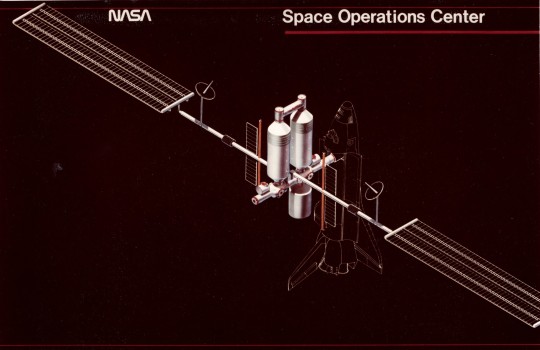

"The SOC is a self-contained orbital facility built up of several Shuttle-launched modules. With resupply, on-orbit refurbish- ment and orbit maintenance, it is capable of continuous operation for an indefinite period. In the nominal operational mode, the SOC is manned continuously, but unmanned operation is possible.
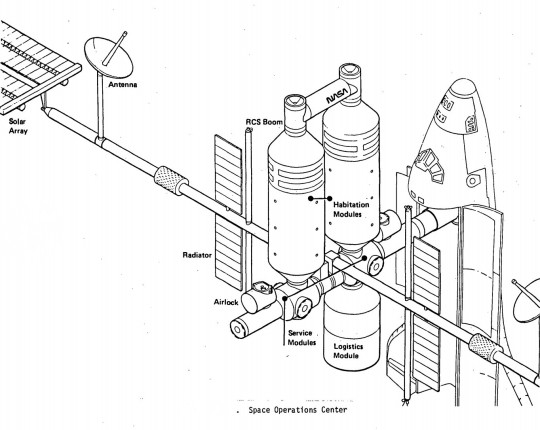
The present mission management and control process is characterized by a people-intensive ground monitoring and control operation involving large supporting ground information and control facilities and a highly- integrated ground-flight crew operation. In order to reduce dependence on Earth monitoring and control, the SOC would have to provide for increased systems monitoring; fault isolation and failure analysis, and the ability to store and call up extensive sets of data to support the onboard control of the vehicle; and the onboard capability for daily mission and other activity planning."
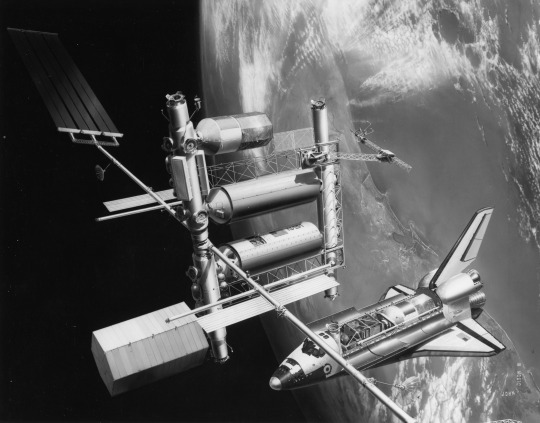

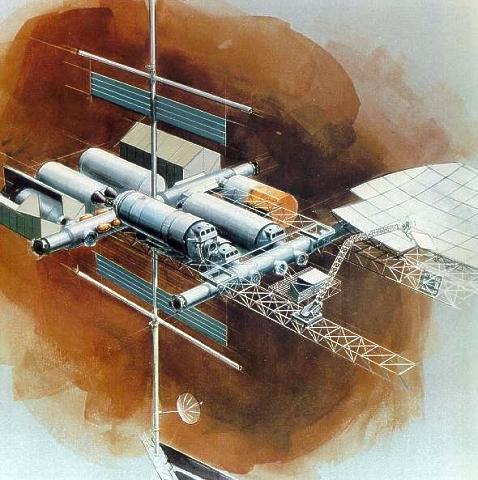
"Like most other space station studies from the mid/late 1970s its primary mission was the assembly and servicing of large spacecraft in Earth orbit -- not science. NASA/JSC signed a contract with Boeing in 1980 to further develop the design. Like most NASA space station plans, SOC would be assembled in orbit from modules launched on the Space Shuttle. The crew's tour of duty would have been 90 days. NASA originally estimated the total cost to be $2.7 billion, but the estimated cost had increased to $4.7 billion by 1981. SOC would have been operational by 1990.
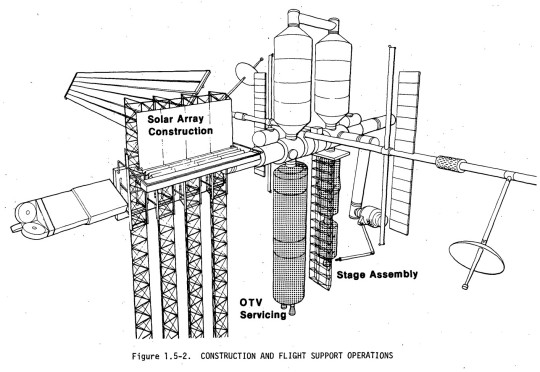
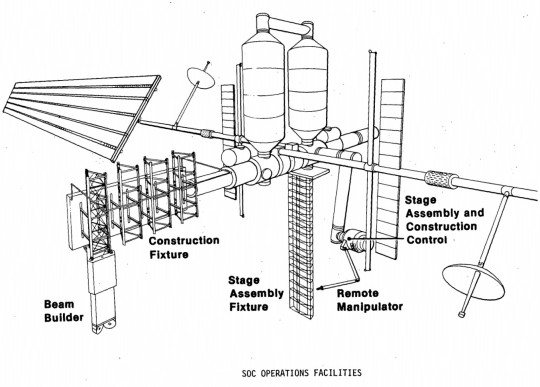

NASA's Johnson Spaceflight Center extended the Boeing contract in February 1982 to study a cheaper, modular, evolutionary approach to assembling the Space Operations Center. An initial power module would consist of solar arrays and radiators. The next launches would have delivered a space tug 'garage', two pressurized crew modules and a logistics module. The completed Space Operations Center also would have contained a satellite servicing and assembly facility and several laboratory modules. Even with this revised approach, however, the cost of the SOC program had grown to $9 billion. Another problem was Space Operations Center's primary mission: spacecraft assembly and servicing. The likely users (commercial satellite operators and telecommunications companies) were not really interested in the kind of large geostationary space platforms proposed by NASA. By 1983, the only enthusiastic users for NASA's space station plans were scientists working in the fields of microgravity research and life sciences. Their needs would dictate future space station design although NASA's 1984 station plans did incorporate a SOC-type spacecraft servicing facility as well."
Article by Marcus Lindroos, from astronautix.com: link

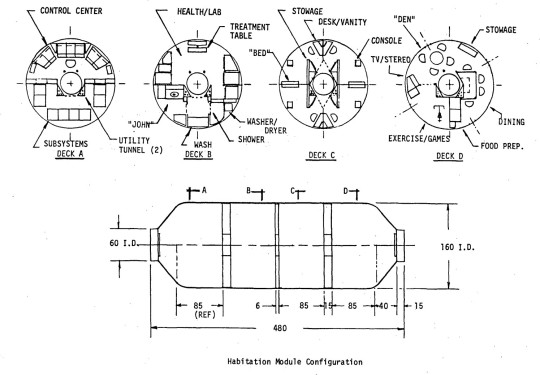


NASA ID: link, S79-10137
Boeing photo no. R-1859, link, link
458 notes
·
View notes
Text

James Jones SpaceX, a journalist and engineering graduate from UCLA, dives deep into the world of SpaceX, Blue Origin, and other space organizations to uncover the motivation and innovation behind their groundbreaking projects. Through his extensive research and interviews with industry experts, James aims to shed light on the incredible work being done by these companies to push the boundaries of space exploration.
1 note
·
View note
Text
Talking Pixels: Hunter Hatchell
My first in a new segment I like to call: Talking Pixels where I interview passionate people in the gaming and tech worlds. Thank you to Hunter Hatchell for the opprtunity to interview him and learning some cool space stuff.. Hope you enjoy!
My first of a new segment: Talking Pixels! At the Indie Galactic Space Jam, I had an opportunity to speak with people close to the Space industry, and former NASA aerospace engineer Hunter Hatchell had a lot to say. We spoke on a variety of topics regarding space, games, and his plans going forward as a space aficionado. The text below is a heavily edited version of our convo. I try to keep as…
#Astronaut#Games#Gaming#Interview#NASA#news#science#Space#Space Industry#spacex#Technology#Video games#VR#XR
0 notes